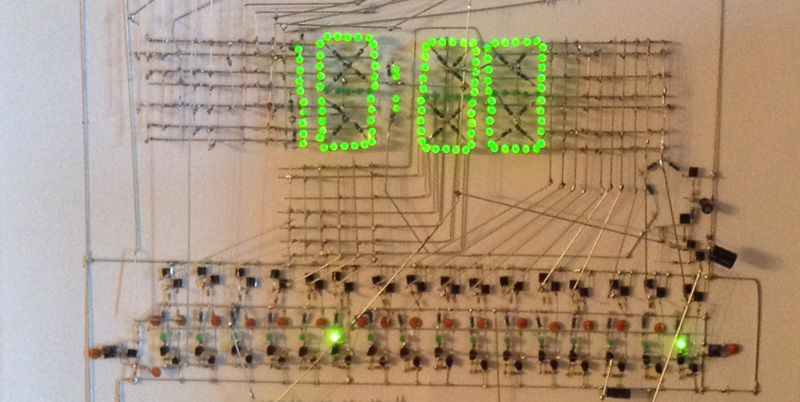[Phil] has already built a few clocks with Nixies, VFDs, and LED matrices. When his son requested his own clock, he wanted to do something a little different. Inspired by the dead bug style of [Jim Williams]’ creations, [Phil] set out to build a clock made entirely out of discrete components. That includes the counters, driver circuits, and an array of LED.
There are a few inspiration pieces for [Phil]’s clock, starting with the Transistor Clock, a mains-powered clock that uses 194 transistors, 566 diodes, and exactly zero integrated circuits. Design patterns from a clock so beautiful it’s simply called The Clock are also seen, as is a Dekatron emulator from [VK2ZAY].
[Phil]’s creation has no PCB, and all the components are soldered onto tiny wires arranged into something resembling the clocks circuit. It’s a fantastic contraption, and while we’ll still have to give the design award to the clock, [Phil]’s creation shows off the functional circuits; great if he’ll ever need to debug anything.
















I want one!!! Imagine this embedded in clear resin…
I’d imagine it’d have to be embedded into something. That wiring looks quite fragile.
Now I want to have a transistor-only hackathon. What would you build? (other than this clock?)
could one enter projects already under construction?
For that thing that’s not planned at all and is only based off of one of Mike’s comments?
Uh, sure.
Seems that you could be just the person to be able to put on such an event.
As for what I would build? Probably a non-functional blob of solder, wires, and melted plastic, though that wouldn’t be what I was aiming for.
…or transistor only contest.
There is a lot of things to build. Music instruments, radio circuits, audio whatever, laboratory power supply, thermostat for terrarium, to name a few.
Transistor ONLY? no, resistors, capacitors, inductors, switches, etc?
you can use fet, mosfet, unijunction (lol), pnp, npn, p-channel, n-channel, si and germanium.
(more than I had when I was growing up)
lol
Could use a BJT as a diode or two. Presumably you could use wires to connect things and not merely leads on a transistor package. I don’t know what the dielectric constant for a package is. A display with thin film transistors may be acceptable. Make a capacitance-detecting circuit somehow as a button, or just touch leads to something as a button.
But the really amazing thing about this kind of contest would be having the spare time. Don’t you other people feel compelled to do something useful??
Yep. No wires, no power supplies. I wrote transistor only. Not even two transistors, just one transistor.
I’m probably the first to ask, but edit button would be handy.
I just finished my one transistor noise generator. Where do I enter?
I’m also working on a one transistor light detector. And I am trying to make a one transistor light, but can’t get it to work for more than a few milliseconds. In the process, I did, however, discover a one transistor smoke generator circuit.
I am making a one transistor attenuator. I will only need two legs of the transistor and I will probably be able to get around dB attenuation.
Why make the hackathon so limited. Couldn’t it be “doing something the hard way – obtain the greatest distance between the logical solution and what you actually make”.
Divide into sections … under $10, under $50, under $100 etc to make it suitable for all.
Maybe another clock, but I will only use MOSFETs instead of BJTs and diodes – it is going to be all discrete CMOS including a crystal clock (6 MOSFETs, 2 resistors, 2 caps and 1 crystal) and the power regulator (the only place an IRF4905 is called for, among all those BS170s and BS250s)
Why, a 555 of course :)
super effort. lots of work!
(cred points auto-added to account) ;)
makes me shudder thinking about a cold solder joint
it’s probably a good idea to reflow it in the oven just to be sure.
I think not. Unless you are able to release the tensions on all the wires first. :)
I was thinking the same thing that the circuit would pop in the oven when the solder joints get hot enough.
Now he should repeat it using neon tubes https://www.youtube.com/watch?v=F4v7IDIYiNQ
Already been on HAD http://hackaday.com/2014/09/29/a-nixie-clock-with-neon-bulb-logic/
I remember that one. It’s one thing building logic with transistors but neon lamps, that’s practically savant level. It does make you wonder given enough time, would it be stable enough to create a working micor computer. Perhaps something akin to magnetic core memory with exciter wire wrapped around an array of them or maybe even some form of delay line to simplify memory construction.
I’m guessing a memory mapped approach might fair best.
Build it from scrap of from scratch? I find the title is misspelled.
http://techno-logic-art.com/clock.htm
What about a clock made entirely of mechanical part- gears, levers, and springs- no transistors or tubes at all?
Oh. Nevermind!